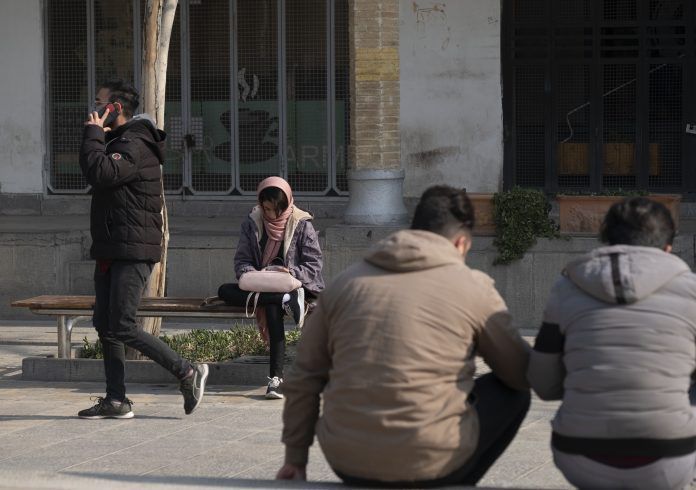
By Kayhan Life Staff
The Majlis (Iranian Parliament) has approved an item in the government’s 2022-23 proposed budget bill which allocates 19 trillion tomans (nearly $634 million, using the market exchange rate of 300,000 rials per dollar) to stimulate population growth.
The state hopes that the plan will encourage young married couples to have large families. Meanwhile, successive Iranian governments have failed to devise coherent plans to tackle high unemployment and improve dire economic conditions for the country’s families, most of which live in poverty and cannot afford to have more children.
[aesop_image img=”https://kayhanlife.com/wp-content/uploads/2021/12/2021-11-04T000000Z_1874415358_MT1NURPHO000QSOBI8_RTRMADP_3_IRAN-ANNIVERSARY-scaled.jpg” panorama=”off” credit=”REUTERS./” align=”center” lightbox=”off” captionsrc=”custom” caption=”FILE PHOTO: Iranian schoolboys hold AK-47 and a UZI guns as they pose for photographs during a ceremony to mark the anniversary of the seizure of the U.S. embassy in downtown Tehran, November 4, 2021. ” captionposition=”left” revealfx=”off” overlay_revealfx=”off”]
The budget bill has not set aside enough funds to pay what the government owes to the national retirement funds, and proposes a cap of 10 percent on salary increases for the 2022-23 calendar year.
In comments reported by the Tehran-based Young Journalist Club (YJC) on Jan. 7, Mohammad Hassan Asafari, a Majlis deputy representing Arak, Komijan, and Khandan electoral districts, said: “The Majlis has approved the [item] in the budget bill, allocating $634 million to help families and population growth.”
Mr. Asafari noted that the Guardian Council had already approved the “Population Growth and Family Act” back in November.
“The bill promotes marriage and urges married couples to have children by tripling the number of subsidies for households in rural areas, providing loans up to $1,000 and 15 percent tax credit for each child,” Asafari added.
The state hopes to increase its grassroots support by offering financial incentives to families to have more children, most of whom are from the poor and the disadvantaged segments of society, with little or no education. However, it is unclear how these families will provide for these children under such challenging economic conditions.
President Mahmoud Ahmadinejad’s cabinet (in office from 2005 to 2023) launched the campaign to encourage families to have more children, which all subsequent governments have promoted. Iran’s Supreme Leader Ayatollah Ali Khamenei has attributed the rapid development of China and India to their large populations.
In reality, many Indians and Chinese emigrate to other countries, searching for better-paying jobs, promising careers, and economic opportunities.
The 2022-23 budget bill is likely to increase the deficit significantly. Dire economic conditions have increased the number of people who sleep rough in cardboard boxes with no known address. Most low-income families have difficulty feeding their children or sending them to school. Many pregnant women are malnourished because of the high cost of medicines and food supplements.
Behrouz Morovati, the director of the Campaign for the Disability Rights, recently said: “Hyperinflation combined with the coronavirus crisis have made life challenging for many disabled people, forcing some to even sell their wheelchairs.”
“Most disabled people receive mere $12 [a month] in welfare benefits, which is not enough to make ends meet,” Mr. Morovati added.
ANALYSIS: A Close Look At Iran’s 2022-23 Proposed Budget Bill
According to the Statistical Center of Iran (SCI), the unemployment rate among people 15 years and older was 9.6 percent in the summer of 2021, showing a 0.8 percent increase compared to the spring of the same year.
The wages of those with jobs are not adjusted according to the cost-of-living index. The Ministry of Cooperatives, Labor, and Social Welfare set the minimum wage at $88.5 a month in 2021. The poverty line for a household of three or four was $400 a month in the fall of the same year.
The massive discrepancy between wages and the high cost of food products has forced many families to reduce their meat, poultry, dairy, and fruits consumption or eliminate them from their diet entirely. Many vegetable and fruit markets have experienced a 30 to 50 percent drop in sales. They have reported a significant increase in demand for their discarded products.
According to Dr. Zahra Abdollahi, spokesperson for the Ministry of Health and Medical Education’s office for improving community health, the consumption of dairy products has dropped by 30 percent in the country.







